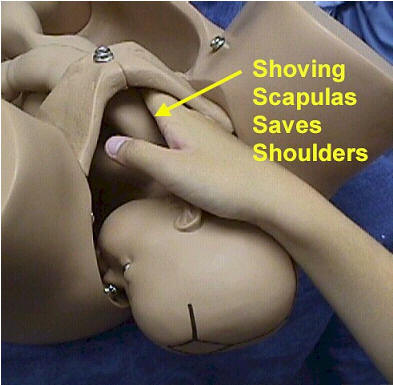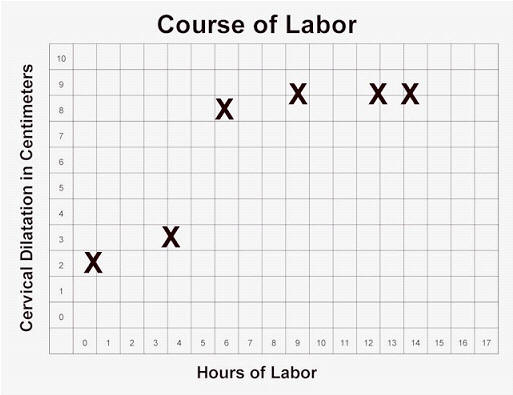
While postponing delivery, many fetuses less than 34
weeks gestation will benefit from administering steroids to the
mother. The effect of the steroids on the fetus is to accelerate fetal
pulmonary maturity, lessening the risk of respiratory distress
syndrome of the newborn. Appropriate doses include:
When transporting the mother to a definitive care
setting, have her remain way over on her left or right side, with a
pillow between her knees, and an IV securely in place. If IV access is
lost during a bumpy truck or helo ride, it will be nearly impossible
to restart it without stopping or landing.
Premature Rupture of Membranes
Most women will rupture their membranes during labor.
If membranes rupture prior to the onset of labor, this is called
premature rupture of the membranes, or PROM.
The obstetrical significance of PROM is that labor
needs to begin promptly or infection will develop with bacteria
ascending through the birth canal. In some cases of PROM, the reason
the membranes rupture prematurely is because there is an established
infection which has weakened the membranes.
If the pregnancy is at full term and there is no
evidence of infection, no treatment is necessary initially, because
most women will go into spontaneous labor within the next 6 hours.
After 6 hours of rupture, or in the face of infection or other
pressing clinical circumstance, labor can be induced. Unless infection
is evident, antibiotics are not helpful.
When PROM occurs remote from term, two basic
approaches can be taken...induce labor or wait for the fetus to mature
further. There are pros and cons to each approach and the decision
will hinge on individual clinical circumstances. This decision is best
made in consultation with a definitive care facility.
Confirmation of PROM is optimally made via a sterile
speculum examination, looking for pooled amniotic fluid in the vagina,
Nitrazine positive fluid, ferning positive fluid, and to obtain a
culture of the fluid.
Shoulder dystocia means difficulty with delivery of the
fetal shoulders.
Although this is more common among women with gestational
diabetes and those with very large fetuses, it can occur with babies
of any size. Unfortunately, it cannot be predicted or prevented. It
probably occurs to some degree in between 1% and 5% of all deliveries,
depending on the patient population, the experience of the operator,
definitional differences, and the accuracy of reporting.
Shoulder dystocia is a dangerous condition because:
-
If not relieved, it can lead to fetal death, and
-
There is a significant risk of injury to the nerves in
the neck from stretching or tearing.
Suspect a shoulder dystocia if, after delivery of the
head, the fetal head partially withdraws back into the birth canal
(the "Turtle Sign"). This occurs because the anterior shoulder is
stuck behind the pubic symphysis. Insert one finger vaginally, and you
will be able to feel the shoulder stuck behind the pubic bone.
In more severe cases, the posterior shoulder may be stuck
at the level of the sacral promontory.
You should immediately call for extra help since many of
the maneuvers you will need to perform will require more than a single
person.
Avoid Excessive Downward Traction
Try to avoid applying excessive downward traction to the baby's head.
This traction can cause or aggravate injury to the nerves in the neck
and shoulder (brachial plexus palsy).
While most of these nerve injuries heal spontaneously and
completely, some do not.
Generous Episiotomy
A generous episiotomy can be helpful. If a spontaneous laceration has
occurred, or if the perineum is very stretchy and offers no
obstruction, then it is not necessary to also perform an episiotomy.
However, if there is any soft tissue obstruction or if the perineum
interferes with your ability to perform extraction maneuvers, it is
wise to place a large episiotomy, a second episiotomy, or extend a
perineal laceration with scissors to obtain more room. Some physicians
will perform an intentional 4th degree extension (proctoepisiorrhaphy)
in order to facilitate delivery. The 4th degree extension can usually
be easily repaired without any long-term consequences for the mother
and provides excellent exposure for the delivery.
Gentle downward traction
can be attempted initially to try to free the shoulder.
If this has no effect, do not exert increasing pressure.
Instead, try some alternative maneuvers to free the shoulder.
MacRobert's Maneuver
The MacRobert's Maneuver involves flexing the maternal thighs
tightly against her abdomen. This can be done by the woman herself or
by assistants.
By performing this maneuver,
-
The axis of the birth canal is straightened, allowing a
little more room for the shoulders to slip through, and
-
The pressure of the mother's thighs on her abdomen
provides the equivalent of suprapubic pressure to dislodge the
shoulder from behind the pubic bone.
With the patient in the MacRobert's position, you can try
gentle downward traction again. If gentle traction has no effect, stop
the traction and try another maneuver.
Suprapubic Pressure
Suprapubic pressure can be applied to drive the fetal shoulder
downward, clearing the pubic bone.
It is usually easiest to have an assistant apply this
downward pressure while you apply coordinated, gentle downward
traction and the mother bears down.
Sometimes, the suprapubic pressure is more effective if
applied in a somewhat lateral direction, rather than straight down.
This tends to nudge the shoulder into a more oblique orientation,
which in general provides more room for the shoulder.In other cases,
straight downward pressure is just what is need to disimpact the fetal
shoulder.
Gentle downward traction on the fetal head in combination
with this suprapubic pressure, maternal pushing efforts and
MacRobert's position may relieve the obstruction. If not, stop the
pushing and pulling efforts, and try another maneuver.
Deliver the Posterior Arm
Often, by the time the fetal head has delivered, the posterior arm has
entered the hollow of the sacrum. By reaching in posteriorly and
sweeping the arm up and out of the birth canal, enough additional
space will be freed to allow the anterior shoulder to clear the pubic
bone.
This graphic makes the maneuver look easier than it is.
Because of limited visibility and space, this maneuver is sometimes
difficult or impossible.
Identify the posterior shoulder and follow the fetal
humerus down to the elbow. Then you can identify the fetal forearm.
Grasping the fetal wrist, draw the arm gently across the chest and
then out. Once the posterior arm has delivered, you can try each of
the previous maneuvers again as you have reduced the bisacromial
diameter and it will be easier for the anterior shoulder to descend.
Screw Maneuver
If you try to remove an electric light bulb by simply pulling on it,
it won't work. If, however, you unscrew the light bulb, it comes out
relatively easily.
The concept of unscrewing the light bulb can be applied
to shoulder dystocia problems.
This example shows pushing the anterior shoulder in a
counterclockwise direction. As the baby rotates, the posterior
shoulder comes up outside of the subpubic arch. At the same time, the
stuck anterior shoulder is brought posteriorly into the hollow of the
sacrum. As the rotation continues a full 360 degrees, both shoulders
are rotated (unscrewed) out of the birth canal.
It is sometimes easier to perform this maneuver with your
hand on the posterior shoulder, rotating it up. If you have enough
room in the pelvis, using both your hands, one on the posterior
shoulder and one on the anterior shoulder can produce excellent
results.
In cases where both the anterior and posterior shoulder
are stuck, the baby may need to be rotated twice. The first rotation
brings a shoulder down into the hollow of the sacrum, while the second
rotation brings that shoulder up and outside the subpubic arch.
Two variations on the unscrewing maneuver include:
-
Shoving the shoulder towards the fetal chest ("shoving
scapulas saves shoulders"), which compresses the
shoulder-to-shoulder diameter, and
-
Shoving the anterior shoulder rather than the posterior
shoulder. The anterior shoulder may be easier to reach and simply
moving it to an oblique position rather than the straight up and
down position may be sufficient
Applying fundal pressure in coordination with other
maneuvers may, at times, be helpful. Applied alone, it may aggravate
the problem and increase the risk of injury by further impacting the
shoulder against the symphysis. You also run the risk of uterine
rupture if the fundal pressure is applied too vigorously or at the
wrong time.
If these maneuvers have failed, it is appropriate to
repeat them in various combinations, and with increasing forcefulness.
While the increased forcefulness may increase the risk of shoulder
injury, the baby must ultimately be delivered or it will die.
Despite careful attention to detail and skillful
performance of these maneuvers, some babies will still have a nerve
injury. No maneuver, no matter how skillfully performed, can prevent
all nerve injuries. But the best chance for avoiding injuries comes
when shoulder dystocia is approached in a careful, systematic way,
with progressive increases in the forcefulness of the maneuvers, until
just the right combination of just the right forces delivers the baby.


